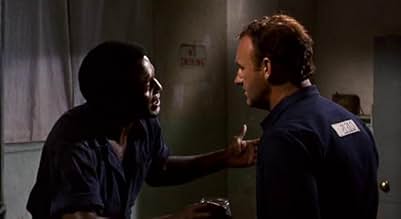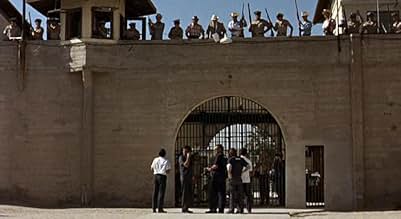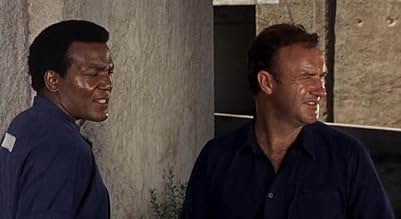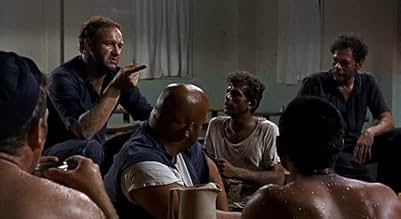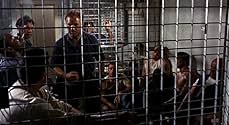Agrega una trama en tu idiomaA riot in a state prison is staged to cover up an escape attempt, during which many inmates and guards are killed. Shot on location at Arizona State Prison.A riot in a state prison is staged to cover up an escape attempt, during which many inmates and guards are killed. Shot on location at Arizona State Prison.A riot in a state prison is staged to cover up an escape attempt, during which many inmates and guards are killed. Shot on location at Arizona State Prison.
- Dirección
- Guionistas
- Elenco
- Dirección
- Guionistas
- Todo el elenco y el equipo
- Producción, taquilla y más en IMDbPro
Opiniones destacadas
Every prison throughout the world, whether state or Federal is an enclosed pressure cooker capped by an ever tightening lid of anger, hate and frustration. Within the walls are a collection of unruly, unpredictable, undisciplined gathering of misfits, murderers and anti-social types. For the most part they are watched and guarded so they do not escape their confinement which is the location for the film called " Riot. " Jim Brown stars as Cully Briston with Gene Hackman as Red Fraker. Although, Cully is to be released in a couple of months, 'Red' and his fellow inmates stage a small takeover in the infirmary which spills over to the detention ward. Having little to do with the initial incident, Cully nevertheless becomes part of the escalating situation when he helps his friends. Gerald O'Loughlin, plays one of the more contentious prison guards who has been throwing his weight around for years in the prison, suddenly feigns sickly and fragile in the face of death. Meanwhile, the Warden who has been vacationing, returns and orders the prisoners to cease and desist. As he prepares to send in his Riot-Squads, the prisoners plan on escaping with an Indian guide called Surefoot. (Ben Carruthers) The seconds tick away and the situation becomes hopelessly unmanageable. The Warden, the Guards and the prisoners all await the next turn of events. Strong character drama from Brown, Hackman and Mike Kellin give this feature a realistic aura and one sure to make high drama for the audience. Good Film and one of the best performances for Jim Brown. ****
RIOT is a 1969 shoestring B production that looks like a made for TV time-passer with Jim Brown at the top of his game, and Gene Hackman, fresh from his small but eye-catching part in BONNIE AND CLYDE (1967) on his way up, with stardom assured two years later as copper Popeye Doyle in FRENCH CONNECTION. The two men had already appeared together in THE SPLIT (1968)
Substandard photography does not hurt the film, rather adding to its credibility as a tale about a breakout from a dingy jail with inhuman guards. Good singing from Bill Medley - great voice - as part of somewhat uneven score. Generally effective dialogue ahead of its time by including gay prisoners, shocking ending.
Competent direction from William Castle, who made his name in horror movies but does a competent job with RIOT. 7/10.
Substandard photography does not hurt the film, rather adding to its credibility as a tale about a breakout from a dingy jail with inhuman guards. Good singing from Bill Medley - great voice - as part of somewhat uneven score. Generally effective dialogue ahead of its time by including gay prisoners, shocking ending.
Competent direction from William Castle, who made his name in horror movies but does a competent job with RIOT. 7/10.
Cool song "100 Years" sung by Bill Medley, music by Christopher Komeda. Shot on location at Arizona State Prison. Great performances by Jim Brown and Gene Hackman. A cool moment is the dream Cully Briston (Jim Brown) has when he takes a nap in the cell. The last 15 minutes of the film are also the best, the ones full of suspense. The rest of the movie is tense boredom.
I realized in time for his centenary tribute that this tense jailbreak thriller was produced by William Castle; the film does not have much of a reputation, however, and is perhaps most notable for being one of a number of transitory parts for Gene Hackman between his acquiring fame in BONNIE AND CLYDE (1967) and stardom via THE FRENCH CONNECTION (1971) – another such effort, THE SPLIT (1968), had partnered him with Jim Brown (who also assumes the leading role here). Indeed, Hackman's superiority in the acting stakes – despite essentially playing second- fiddle to ex-American Football luminary Brown – in comparison to the other participants (more on this later) is palpable throughout. Having said that, Gerald S. O'Loughlin is initially set out as the prisoners' chief nemesis but his contribution gradually diminishes once the titular event takes centre-stage.
The movie is basically an updated and more brutal version of earlier prison dramas, the obvious prototype being Don Siegel's noir classic RIOT IN CELL BLOCK 11 (1954). What is interesting in this case is that the riot is borne out of an attempted mass escape of the isolation division; when the latter is foiled, mastermind Hackman decides to buy some time – ostensibly negotiating system reforms with the authorities on the outside (as it happens, the fearsome warden has chosen this precise moment to take a break!) – while a tunnel is being laboriously dug from under the auditorium to freedom just past the walls of the vast compound!! Incidentally, Castle is to be commended for shooting this in an authentic Arizona correctional facility – with not only the real-life warden filling his respective shoes within the narrative (I wonder whether he was aware of how unsympathetically his office was being depicted!) but also a number of the convicts themselves!!
As I said, the film features a number of contemporary trappings which, frankly, do it (and even more so the genre involved) no more than a disservice – notably a substance-fuelled party by the inmates, with a handful of them in drag so as to titillate their 'colleagues'; one of them even invites coloured macho Brown to his cell, but he obviously backs off (preferring to envision a clutch of bikini-clad 'sisters' in the movie's one scene with female presences, drooling over him)! Similarly over-the-top are the actions of a wacky knife-happy Indian who constantly antagonizes Brown, and whom Hackman needs tagging along in order to supply guidance in their eventual flight to Mexico only to have his throat memorably slit by him at their very moment of glory (many of the intended fugitives had already been routed by the shrewd warden)! Among the assets, then, are the pristine DVD-sourced look and Krzysztof Komeda's unusual score (albeit backed by a recurring wistful ballad that acts as Brown's theme tune), the esteemed Polish composer's last effort prior to his untimely tragic death – and which ties the picture with Castle's much more distinguished production ROSEMARY'S BABY (1968).
The movie is basically an updated and more brutal version of earlier prison dramas, the obvious prototype being Don Siegel's noir classic RIOT IN CELL BLOCK 11 (1954). What is interesting in this case is that the riot is borne out of an attempted mass escape of the isolation division; when the latter is foiled, mastermind Hackman decides to buy some time – ostensibly negotiating system reforms with the authorities on the outside (as it happens, the fearsome warden has chosen this precise moment to take a break!) – while a tunnel is being laboriously dug from under the auditorium to freedom just past the walls of the vast compound!! Incidentally, Castle is to be commended for shooting this in an authentic Arizona correctional facility – with not only the real-life warden filling his respective shoes within the narrative (I wonder whether he was aware of how unsympathetically his office was being depicted!) but also a number of the convicts themselves!!
As I said, the film features a number of contemporary trappings which, frankly, do it (and even more so the genre involved) no more than a disservice – notably a substance-fuelled party by the inmates, with a handful of them in drag so as to titillate their 'colleagues'; one of them even invites coloured macho Brown to his cell, but he obviously backs off (preferring to envision a clutch of bikini-clad 'sisters' in the movie's one scene with female presences, drooling over him)! Similarly over-the-top are the actions of a wacky knife-happy Indian who constantly antagonizes Brown, and whom Hackman needs tagging along in order to supply guidance in their eventual flight to Mexico only to have his throat memorably slit by him at their very moment of glory (many of the intended fugitives had already been routed by the shrewd warden)! Among the assets, then, are the pristine DVD-sourced look and Krzysztof Komeda's unusual score (albeit backed by a recurring wistful ballad that acts as Brown's theme tune), the esteemed Polish composer's last effort prior to his untimely tragic death – and which ties the picture with Castle's much more distinguished production ROSEMARY'S BABY (1968).
8tavm
While I had watched this movie previously in the '90s, I forgot many of the details such as a dream sequence of Jim Brown being surrounded by a bevy of young black women in bikinis at a swimming pool or the following scene of the homosexual prisoners dressing up in drag. Quite exciting especially during the second half when the warden returns from his vacation and decides to fire away, his staff being held hostage damned. And, yes, Gene Hackman is also very good as a fellow prisoner who instigated the whole thing with Brown being a reluctant participant. So on that note, Riot is highly recommended. P.S. That Bill Medley song sure is hauntingly effective every time it plays on the score.
¿Sabías que…?
- TriviaArizona State Penitentiary warden Frank Eyman and 600 inmates and prison staff appear in the movie.
- Versiones alternativasAn edited, "PG" rated version was released to theaters in 1970. Video version is the complete "R" rated version.
- ConexionesReferenced in Summer in the City (1971)
- Bandas sonorasRAG MOP
Words and Music by Johnny Lee Wills and Deacon Anderson
Selecciones populares
Inicia sesión para calificar y agrega a la lista de videos para obtener recomendaciones personalizadas
- How long is Riot?Con tecnología de Alexa
Detalles
- Tiempo de ejecución1 hora 36 minutos
- Mezcla de sonido
- Relación de aspecto
- 1.85 : 1
Contribuir a esta página
Sugiere una edición o agrega el contenido que falta

Principales brechas de datos
By what name was Motín (1969) officially released in India in English?
Responda

